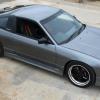Stock 180sx/ Stock R33
Announcements
-
Similar Content
-
Latest Posts
-
This seems like a pointless exercise. There is no E30 availability. Ongoing availability of E85 should not be assumed. Flex-fuel is the only sensible approach, so you can use E85 when and where you can get it, 98 when that's al you can get, and anything in between as you fill it up and drain it down. And if that means replacing the pumps, fitting a flex capable sensor/ECU/whatever has to be done to these Renault shitboxen, then.....so be it?
-
Sorry, I wasn't very clear.....just that the standard injectors are apparently good over 600rwhp/450rwkw which you won't get to on standard turbos anyway.....they are much better sized from factory than we are used to in RBs.
-
I'm not sure where you are, but United Terrey Hills has E85.
-
By Murray_Calavera · Posted
Do you mean not a limit to a certain power level? Surely if an injector is 100% open, there will be a limit to how much fuel can flow through it.
-






Recommended Posts
Create an account or sign in to comment
You need to be a member in order to leave a comment
Create an account
Sign up for a new account in our community. It's easy!
Register a new accountSign in
Already have an account? Sign in here.
Sign In Now